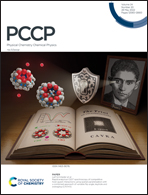Full-dimensional potential energy surface for the H + CH3OH reaction. Theoretical kinetics and dynamics study†
Abstract
The dynamics and kinetics of the abstraction reactions of hydrogen atoms with methanol have been studied using quasi-classical trajectory calculations and variational transition state theory with tunnelling corrections, based on a new analytical potential energy surface (PES). The new PES is a valence-bond/molecular mechanics (VB/MM) expression that provides us with the potential energy for any set of Cartesian coordinates. Two reaction channels are considered: hydrogen abstraction from the methyl group (R1) and hydrogen abstraction from the alcohol group (R2), R1 being much more likely to occur in the wide temperature range under study (250–1000 K), as expected from the lower barrier height. Our dynamic calculations at a collision energy of 20 kcal mol−1 show that the H2 co-product is produced mainly in its vibrational ground-state and little rotation excitation is found. As for our kinetic results, they agree with those from previous theoretical studies as well as with those from kinetic experimental results (rate constants and kinetic isotopic effects), lending confidence to the analytical PES presented here. Thus, we expect this PES to be a simple yet powerful tool to understand such an important reaction in combustion chemistry at very high temperatures and interstellar chemistry at very low temperatures.



 Please wait while we load your content...
Please wait while we load your content...